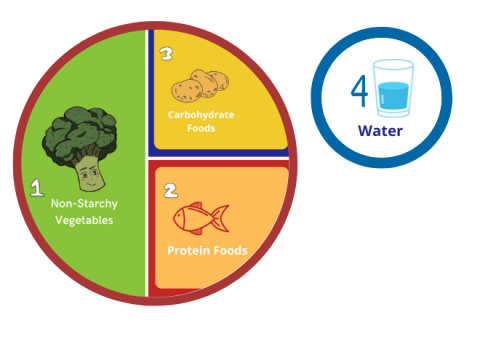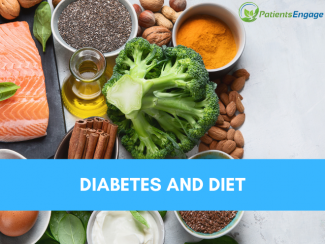Rima Rao, Registered Dietitian explains the basic tenets of a wholesome diet to manage diabetes, using the Diabetes Plate Method. She also addresses the topic of when and how much fruit a person with diabetes can consume.
"What should I eat?" is a typical question that people with diabetes ask. There is, however, no such thing as a “Diabetes Diet.” Some things that you can do include changing how you cook, how much you eat, when you eat it and what you cook with.
When it comes to figuring out your meal plans, you should take quality as well as quantity into account. There are plenty of healthy options and patterns that can help you deal with your diabetes. As long as you include a good quantity of non-starchy vegetables, minimize added sugars and refined grains, and choose whole foods, you should be good to go.
Of course, what exactly you should eat depends on individual attributes such as age, gender, lifestyle, extent of exercise, cultural contexts, locally available foods and dietary customs. Yet, the essence of a healthy diet remains the same.
Recent research is proving that low-carbohydrate foods can help, but there is no way to define “low carb” accurately and with a singular focus. If you follow this approach, ensure that you retain dietary fibers in your diet. The key is to minimize risks and maximize success.
Replacing some kinds of foods with their alternatives are easy ways for people with diabetes to reduce their risk of cardiovascular and kidney diseases; for instance, replace foods high in saturated fat, such as butter and red meat, with foods rich in unsaturated fats, like olive oil and fish or paneer/tofu.
Opting for a diet that is high in fiber, protein and healthy fats can help you manage your diabetes better by maintaining your blood sugar levels. Nutrient-rich snacks can also help in this regard.
The Diabetes Plate Method enables you to portion out your meals with the relevant balance of vegetables, protein and carbohydrates without needing to weigh or measure anything. As long as you take a plate that is 9 inches in diameter, you can figure out the portions easily.

Diabetes Plate Method
1. Non-starchy vegetables in half the plate
Non-starchy vegetables have lower carbohydrates, reducing the risk of raising blood sugar. They further contain vitamins, minerals and fiber, making them essential elements of a healthy diet. Ensuring this balance will give you a good portion with foods such as broccoli, cabbage, cucumber, zucchini, okra (bhindi), leafy greens, radish leaves, beetroot leaves, water spinach (kalmi), mushrooms, green beans, French beans, broad beans, cluster beans, tomatoes etc.
2. Lean protein foods in one quarter of the plate
A healthy person needs 0.8 to 1 g protein/kg. This can vary according to one’s age, extent of exercise, underlying conditions and more. Do not reduce your protein intake as this can lead to muscle loss, lowered metabolism, low energy levels, fatigue, lowered immunity, anemia. Protein should be included in every meal of the day to reduce post-meal glucose levels. High protein meals help to achieve hunger satisfaction while also controlling blood glucose levels.
Some high protein foods tend to have saturated fat which can put you at risk of heart disease.
Too much fat can lower the absorption rate of glucose from the food, but since it contains lots of calories, it’ll end up making itself visible in your weight and blood sugar. Make sure you focus on the quality of fats and oils as well. Keep visible fats to 3 teaspoons per day and avoid refrying and reheating of oils. Avoid bakery goods, Vanaspati, processed and ultra-processed foods should as far as possible as they contain Trans fats that increase the bad cholesterol (LDL) and decrease the good cholesterol (HDL), leading to a risk of obesity, heart disease and cancer. Healthy fats or unsaturated fats found in many plants and seeds are good for the heart but high in calories, so eat them sparingly.
Certain plant-based protein foods (like beans and legumes) are also high in carbohydrates. These are also not complete proteins, so use them as cereal pulse mixes to complete the protein.
Examples of lean protein foods include chicken, turkey, eggs, fish, shellfish, lean beef cuts, lean pork cuts, lean meats, cheese, paneer, beans, lentils, pulses, hummus, sprouts, nuts and nut butters, peanuts, tofu, tempeh, plant-based meat substitutes, soya milk, seeds like sesame, flax, chia, pumpkin, sunflower, hemp and more.
3. Carbohydrate foods for one quarter of the plate
Grains (rice, ragi, wheat, bajra, jowar, oats, sooji, maida), starchy vegetables (green peas, plantain, potato, pumpkin, yam, sweet potato, squashes) beans and legumes, fruit, dried fruits, curds, and milk all have high carbs. These foods have the biggest impact on blood sugar.Our bodies break them down into glucose immediately, leading to a rise in blood sugar. This can also depend on the type of carbohydrate itself—complex, simple or refined.
Complex carbohydrates are rich in fiber and nutrients, take longer to breakdown, provide more satiety and energy that you can sustain for longer. Some examples of these are whole grains, pulses, sprouts, soyabeans and root vegetables.
Simple carbs break down much quicker and provide immediate energy to our bodies.
Refined carbs are processed rapidly by the body, causing the blood sugar level to increase. Examples include refined sugar, honey and fruit juices. These are found in the hidden sugars of packaged or processed foods like energy bars, yoghurt, instant meals, salad dressings, readymade pasta sauces, ketchup, fruity breakfast cereals, energy drinks, canned fruits, dried fruit, chocolates, spreads, biscuits, cookies, and pastries.
You can reduce their intake by scanning food labels, carrying out comparisons and opting for products with low sugar. You can find these sugars labeled as corn sugar, dextrose, fructose, agave syrup, maple syrup, maltose, molasses, sucrose on the food labels.
4. Water or a low-calorie drink
Drink water with your meal. It does not have any calories or carbohydrates, leading to zero alteration of blood sugar. Other drink options you can consider are:
• Unsweetened tea or coffee (hot or cold)
• Sparkling water
• Thin buttermilk
You can also make use of this plate method while preparing combination foods.. A great example is the standard Indian thali where a combination of foods is eaten like roti (carbohydrates), subji (vegetables), khichadi (carbohydrates and proteins), pulao/biryani (carbohydrates and vegetables) and curd (proteins).Try to make combination dishes with compatible proportions in terms of the plate size. Opt for more vegetables and lentils as compared to roti or rice. Opt for curds/lassi, green leafy vegetables as well as low glycemic index vegetables.
Role of Fruits
Fruits usually have carbohydrates natural sugar (fructose), which is capable of raising blood sugar levels. Yet, you can include it in your meals since it has other healthy nutrients like vitamins, minerals and fiber. Fibers can slow down your digestion, preventing sharp increases in blood sugar. It also makes you feel satisfied, allowing you to maintain a healthy weight.
Eat fruit in controlled amounts to gain several benefits such as a reduced risk of heart diseases and cancer while also improving overall immunity due to the presence of phytochemicals that can serve as antioxidants. This is significant since diabetes is associated with a higher risk of chronic degenerative diseases. Avoid dried fruit and fruit juice.
Effects on Blood Sugar: Glycemic Index and Glycemic Load
Foods that have high carbs can affect blood sugar in varying ways. These effects can be quantified by measures such as the glycemic index and glycemic load.
The glycemic index (GI) allots a numbered score to a certain food based on how much it can lead to an increase in blood sugar. The scores range from a scale of 0 to 100, with pure glucose (sugar) having a score of 100. Lower GI can imply a lower rate of blood sugar increase in the body. Highly processed foods have a higher GI whereas higher fat or fibers have a lower GI. To figure out how certain foods can impact the blood sugar, you need to know how quickly it causes glucose to enter the bloodstream and how much glucose per serving it can deliver.
A separate measure called the glycemic load (GL) performs both functions by providing a precise idea of a food's actual effect on your blood sugar. Watermelon, for instance, has a high GI (80) but a single serving has such little carbohydrate that its GL is only 5.
Eating too much of low-GI food will end up raising your blood sugar in the same way as a small amount of a high-GI food. For instance, an orange has a GI of 52 but a glycemic load of 4.4 while a candy bar and a cup of brown rice tend to have the same GI. A candy bar with a GI of 55 can contain a GL of 22.1. (The complete list of the glycemic index and glycemic load for more than 1,000 foods can be found in the article "International tables of glycemic index and glycemic load values: 2008" by Fiona S. Atkinson, Kaye Foster-Powell, and Jennie C. Brand-Miller in the December 2008 issue of Diabetes Care, Vol. 31, number 12, pages 2281-2283.)
Processing food increases its GI ranking, so fruit juice has a higher score than a whole piece of fruit. Also, whole fruit contains fiber which will increase satiety. Ripe fruit also has a higher GI score than unripe or partially ripe fruit.
Eat high-GI fruit with foods that have low scores. You can do this by pairing some fruit with some nuts so that the glucose released into the blood can take place steadily.
Tip: Eat fresh fruit as a mid-morning or mid-evening snack to ensure a good blood glucose level. Do not eat fruits with a meal or after a meal as this can increase the carbohydrate intake considerably.
The recommended daily intake of fruits someone with diabetes can eat depends on their specific blood glucose level and other associated conditions such as obesity. You can eat two portions of fruits providing 15g carbohydrates each at different times of a single day, although you should account for the serving size and type of fruit as well. For example, you can get 15 grams of carbs from:
• Apple 1 medium
• Banana 1 small
• Pear 1 medium
• Guava 1 medium
• Orange 1 medium
• Pomegranate ½ bowl
• 1 cup blackberries or raspberries
• 3/4 cup blueberries
• 1 1/4 cup whole strawberries
• 1 cup cubed honeydew melon
• 1/8 cup raisins
• Mango 2 slices
• Watermelon 1 bowl
• Cherries 10
• Chikoo 1 small
• Grapes 15
Summing up
What we eat is within our control, allowing us to halt the course of the disease by eating efficiently and smartly. Apart from just controlling the intensity of the disease, it can also reduce our reliance on medications. The main goal is to achieve and maintain a healthy weight which can have a positive impact on your blood sugar and overall health.
Issued as part of the public education series by Boehringer Ingelheim India and PatientsEngage
(Reference: Key Takeaways from American Diabetes Association’s Nutrition Consensus Report - www.diabetes.org)








